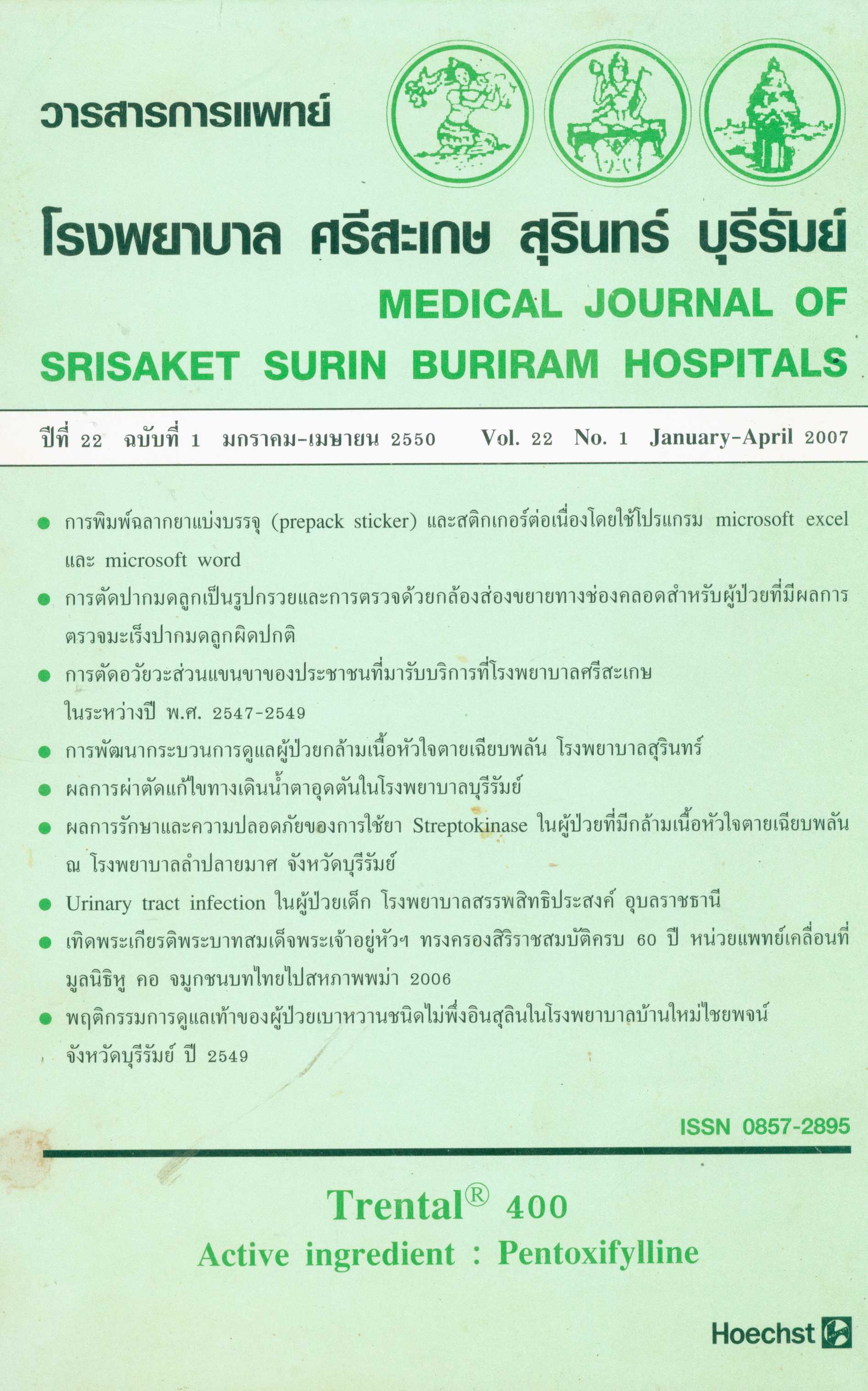Urinary tract infection ในผู้ป่วยเด็ก โรงพยาบาลสรรพสิทธิประสงค์ อุบลราชธานี
Main Article Content
บทคัดย่อ
ความสำคัญ: การติดเชื้อของทางเดินปัสสาวะเป็นโรคที่สำคัญอย่างหนึ่งที่พบบ่อยในเด็ก การตรวจทางรังสีวิทยา การรักษา และภาวะแทรกซ้อนของโรคติดเชื้อทางเดินปัสสาวะ
วัตถุประสงค์ทางการวิจัย: เพื่อศึกษาอุบัติการณ์ อาการ อาการแสดง ผลการตรวจทางห้องปฏิบัติการ การตรวจทางรังสีวิทยา การรักษา และภาวะแทรกซ้อนของโรคติดเชื้อทางเดินปัสสาวะ
สถานที่ศึกษา: กลุ่มงานกุมารเวชกรรม โรงพยาบาลสรรพสิทธิประสงค์
รูปแบบการศึกษา: การศึกษาแบบย้อนหลังเชิงพรรณนา
ประชากรที่ศึกษา: ผู้ป่วยที่ได้รับการวินิจฉัยว่าเป็น UT1 โดยมีผลการเพาะเชื้อจากปัสสาวะยืนยัน เก็บรวบรวมข้อมูลระหว่างวันที่ 1 มกราคม 2547 - 31 ธันวาคม 2549
วิธีการศึกษา: จำนวนกลุ่มตัวอย่าง 127 คน เก็บรวบรวมข้อมูลจากแฟ้มประวัติผู้ป่วย สถิติที่ใช้ในการวิเคราะห์ข้อมูล คือ สถิติร้อยละ
ผลการศึกษา: ผู้ป่วยจำนวน 127 ราย ประกอบด้วย เพศชาย จำนวน 48 คน เพศหญิง 79 คน อัตราส่วนเพศชายต่อหญิงเท่ากับ 1 : 1.6 อายุ > 1 เดือน - 5 ปี ร้อยละ 39.4 อาการสำคัญที่มาพบแพทย์ คือ ภาวะไข้ ร้อยละ 60.0 ตรวจพบ Phimosis ร้อยละ 2.3 ตรวจปัสสาวะพบ WBC น้อยกว่า 50 cell/HPF ร้อยละ 65.3 ระดับ Cr ในเลือดน้อยกว่า 1.5 ร้อยละ 96.0 เพาะเชื้อในปัสสาวะ พบ E. coli ร้อยละ 45.6 ผลตรวจ Ultrasound มี Hydronephrosis ร้อยละ 21.2 VCUG พบความผิดปกติแบบ VUR ร้อยละ 17.7 และ PUV ร้อยละ 2.2 ได้รับการรักษาด้วย Norfloxacin ร้อยละ 22.8 และ Gentamicin ร้อยละ 22.8 พบการติดเชื้อ UTI ซ้ำในผู้ป่วย ร้อยละ 7.0 โดยเกิดใน 1 ปีแรก ร้อยละ 88.8 ยาปฏิชีวนะที่ใช้ป้องกันการติดเชื้อ UTI ซ้ำ คือ Cotrimoxazole ร้อยละ 60.0
สรุปผลการศึกษา: ผู้ป่วย urinary tract infection พบในเพศหญิงประมาณ 1.6 เท่า ของเพศ ชาย อาการสำคัญที่มาพบแพทย์คือภาวะไข้ ผลเพาะเชื้อในปัสสาวะส่วนใหญ่พบ Escherichia coli ภาวะแทรกซ้อนที่พบบ่อย คือ VUR
คำสำคัญ: การติดเชื้อทางเดินปัสสาวะ/กุมารเวชกรรม/โรงพยาบาลสรรพสิทธิประสงค์
Article Details
เอกสารอ้างอิง
2. American Academy of Pediatrics Committee on Quality Improvement Practice parameter. The diagnosis, treatment, and evaluation of the initial urinary tract infection in febrile infant and young children. Pediatrics 1999; 103 : 843-51.
3. Hellerstein S. Urinary tract infection, old and new concepts. Pediatric Clin N Am 1995;42 : 1433-57
4. กาญจนา ตั้งนรารัชชกิจ, วิวัฒน์ ตปนีย์โอฬาร, สมนึก ดำรงกิจชัยพร บรรณาธิการ. การติด เชื้อที่ระบบปัสสาวะ. ก้าวทันวิทยาการโรคไต. กรุงเทพฯ : 2545. หน้า 181-97.
5. Zorc JJ, Kiddo DA, Shaw KN. Diagnosis and management of pediatric urinary tract infections. Clin Microbiol Rev 2005 ; 18 : 417-22
6. Ruangkanchanasetr S, Junnanond C. Fever without localizing signs in young children. J Med Assoc Thai 1986; 69 (Suppl 2) : 50-5.
7. Chon CH, Lai FC, Shortliffe MD. Pediatric urinary tract infections. Pediatr Clin North Am 2001 ; 48: 1441-59
8. Lizama CM and other. “Urinary tract infection in a pediatrics emergency department : frequency and Clinical parameters,” Rev chilena Infectol. 22, 3 (Sep 2005) : 235-41.
9. Sakran W and other “Community acquired urinary tract infection among hospitalized children in northern Israel : pathogens, susceptibility patterns and urinary tract anomalies,” Harefuah. 142, 4 (Apr 2003) : 249-52.
10. Ferry S, Burman LG and Mattsson B. “Urinary tract infection in primary heath care in northern Sweden. II. Clinical presentation,” Scand J Prim Health Care. 5, 3 (Sep 1987) : 176-80.
11. Balzar E. and other “Importance of early diagnosis of urinary tract infections in childhood. Results of a retrospective study of children with vesico - uretero - renal reflux,” Wien Med Wochenschr 141, 23-24 (1991) : 541-3.
12. Cleper R. and other. “Prevalence of vesicoureteral reflux in neonatal urinary tract infection,” Clin Pediatr (Phila) 43, 7 (Sep 2004) : 619-25.
13. Supavekin S. and other. “The relation of vesicoureteral reflux and renal scarring in childhood urinary tract infection,” J Med Assoc Thai. 89, suppl 2 (Aug 2006) : s41-7.
14. Mohanna MA and Raja’a Ya. “Frequency and treatment of urinary tract infection in children subjected to urine culture, in Sana’a, Yemen,” J Ayub Med Coll Abbottabad. 17, 2 (Apr-Jun 2005) : 20-2.
15. Wu CY and other. “Childhood urinary tract infection : a clinical analysis of 597 cases,” Acta Paediatr Taiwan. 45, 6 (Nov-Dec 2004) : 328-33.
16. Qureshi Am. “Clinical presentation of urinary tract infection among children at Ayub Teaching Hospital,” J Ayub Med Coll Abbottabad. 17, 2 (Apr-Jun 2005) : 79-81.
17. Elzouki AY, Mir NA and Jeswal OP. “Symptomatic urinary tract infection in pediatric patients - a developmental aspect;” Int J Pediatr Nephrol. 6, 4 (Oct-Dec 1985) : 267-70.
18. Musa - Aisien As. and other. “Prevalence and antimicrobial sensitivity pattern in urinary tract infection in febrile under 5s at a children’s emergency unit in Nigeria,” Ann Trop Paediatr 23, 1 (Mar 2003) : 39-45.
19. Bouallegue O and other “Bacterio-logic features of urinary tract infections in children in the Sousse area, Tunisia,” Tunis Med. 82, 8 (Aug 2004) : 742-6.
20. Kanellopoulos TA and other “First urinary tract infection in neonates, infants and young children : a comparative study,” Pediatr Nephrol. 21, 8 (Aug 2006) : 1131-7.
21. Tapaneya - Olam C., Tapaneya –Olam W. and Assadamongkol K. “Genitourinary tract anomalies in Thai children with urinary tract infection”, J Med Assoc Thai. 72, Suppl 1 (Jan 1989) : 47-51.
22. Mahant S., Friedman J and Mac Arthur C. “Renal ultrasound findings and vesicoureteral reflux in children hospitalised with urinary tract infection,” Arch Dis Child. 86, 6 (Jun 2002) : 419-20.
23. JothilakshmiK and other. “Radiological evaluation of the urinary tract in children with urinary infection,” Indian J Pediatr. 68, 12 (Dec 2001): 1131-3.


